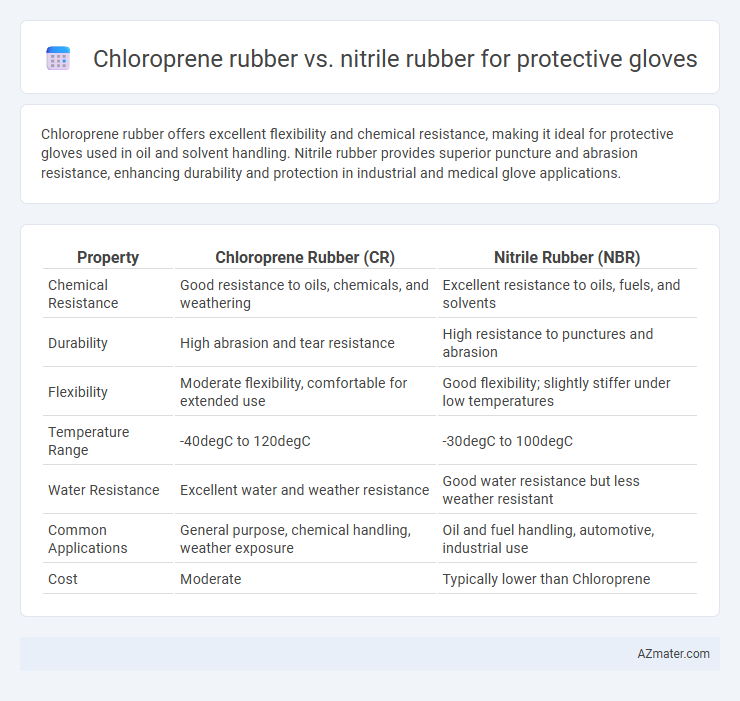Chloroprene rubber offers excellent flexibility and chemical resistance, making it ideal for protective gloves used in oil and solvent handling. Nitrile rubber provides superior puncture and abrasion resistance, enhancing durability and protection in industrial and medical glove applications.
Table of Comparison
| Property | Chloroprene Rubber (CR) | Nitrile Rubber (NBR) |
|---|---|---|
| Chemical Resistance | Good resistance to oils, chemicals, and weathering | Excellent resistance to oils, fuels, and solvents |
| Durability | High abrasion and tear resistance | High resistance to punctures and abrasion |
| Flexibility | Moderate flexibility, comfortable for extended use | Good flexibility; slightly stiffer under low temperatures |
| Temperature Range | -40degC to 120degC | -30degC to 100degC |
| Water Resistance | Excellent water and weather resistance | Good water resistance but less weather resistant |
| Common Applications | General purpose, chemical handling, weather exposure | Oil and fuel handling, automotive, industrial use |
| Cost | Moderate | Typically lower than Chloroprene |
Introduction to Chloroprene and Nitrile Rubber
Chloroprene rubber, known for its excellent chemical stability and flexibility, is widely used in protective gloves for resistance against oils, chemicals, and abrasion. Nitrile rubber offers superior puncture resistance and strong protection against fuels, oils, and many solvents, making it ideal for medical and industrial gloves. Both materials deliver distinctive performance features tailored to varying protective glove requirements in hazardous environments.
Chemical Composition and Structure
Chloroprene rubber, derived from polymerizing chloroprene monomers, features a polychloroprene backbone that provides excellent chemical resistance and flexibility, making it suitable for protective gloves in environments with moderate exposure to oils and solvents. Nitrile rubber consists of copolymers of acrylonitrile and butadiene, with a polar nitrile group that enhances resistance to oils, fuels, and many chemicals, offering superior protection in harsher chemical environments. The molecular structure of chloroprene includes chlorine atoms which improve weather and ozone resistance, while nitrile's polar nitrile groups result in stronger chemical resistance but may compromise flexibility compared to chloroprene.
Key Physical Properties Comparison
Chloroprene rubber offers excellent elasticity, abrasion resistance, and moderate chemical resistance, making it ideal for protective gloves requiring durability and flexibility. Nitrile rubber provides superior resistance to oils, fuels, and solvents with enhanced puncture and tear resistance, suited for gloves used in harsh chemical environments. Both materials exhibit good tensile strength, but nitrile generally outperforms chloroprene in chemical impermeability and puncture resistance.
Chemical Resistance and Durability
Chloroprene rubber offers excellent chemical resistance to oils, acids, and alkalis, making it suitable for protective gloves used in industries involving solvents and chemicals. Nitrile rubber provides superior resistance to petroleum-based oils, fuels, and certain solvents, excelling in environments where oil exposure is frequent. Both materials deliver durability with chloroprene enhancing flexibility and weather resistance, while nitrile is highly abrasion resistant and puncture-proof, ensuring long-lasting glove performance under harsh conditions.
Protection Against Biological Hazards
Chloroprene rubber offers excellent resistance to a wide range of biological hazards, including viruses, bacteria, and fungi, due to its superior chemical stability and barrier properties. Nitrile rubber also provides strong protection against biological hazards, especially in resisting punctures and tears while maintaining high chemical resistance to oils and solvents. For protective gloves, chloroprene rubber is often preferred in medical and laboratory settings for enhanced comfort and durability during prolonged exposure to biological contaminants.
Comfort and Flexibility in Glove Usage
Chloroprene rubber offers superior comfort and elasticity, providing excellent flexibility and a natural feel ideal for prolonged glove usage. Nitrile rubber, while highly resistant to punctures and chemicals, tends to be stiffer, potentially reducing dexterity and comfort during extended wear. For tasks requiring precise movements and all-day comfort, chloroprene gloves generally outperform nitrile in flexibility without compromising safety.
Allergenicity and Skin Sensitivity
Chloroprene rubber offers low allergenicity and chemical resistance, making it suitable for protective gloves worn by individuals with latex allergies or sensitive skin. Nitrile rubber also provides excellent hypoallergenic properties with superior resistance to oils, fuels, and chemicals, reducing skin irritation risk in industrial or healthcare settings. Both materials minimize skin sensitivity compared to natural rubber latex, but nitrile is often preferred for users requiring enhanced protection against harsh substances.
Cost and Availability Analysis
Chloroprene rubber gloves typically offer moderate cost levels with good durability and chemical resistance, making them a popular choice for diverse protective applications. Nitrile rubber gloves, while often priced higher due to superior puncture and chemical resistance, have become widely available as demand grows in industrial and medical sectors. Availability for both materials varies by region, with nitrile gloves generally more accessible globally due to higher production volumes and diversified manufacturing sources.
Application Suitability and Industry Standards
Chloroprene rubber offers excellent chemical resistance, flexibility, and durability, making it ideal for protective gloves used in chemical handling, oil and gas industries, and general-purpose applications. Nitrile rubber provides superior resistance to oils, fuels, and punctures, making it the preferred choice in automotive, medical, and food processing sectors where high durability and barrier protection are critical. Both materials comply with industry standards such as ASTM D6319 for nitrile gloves and EN 420 for general protective glove performance, ensuring reliable safety and application suitability.
Conclusion: Choosing the Right Protective Glove Material
Chloroprene rubber offers excellent chemical resistance, flexibility, and durability, making it ideal for handling a wide range of chemicals and providing comfort during prolonged use. Nitrile rubber excels in puncture resistance and is highly effective against oils, fuels, and certain chemicals, making it suitable for industrial and medical applications where durability is critical. Selecting the right protective glove material depends on specific exposure risks and required dexterity, with chloroprene favored for broad chemical protection and nitrile preferred for enhanced mechanical strength and oil resistance.

Infographic: Chloroprene rubber vs Nitrile rubber for Protective glove
 azmater.com
azmater.com